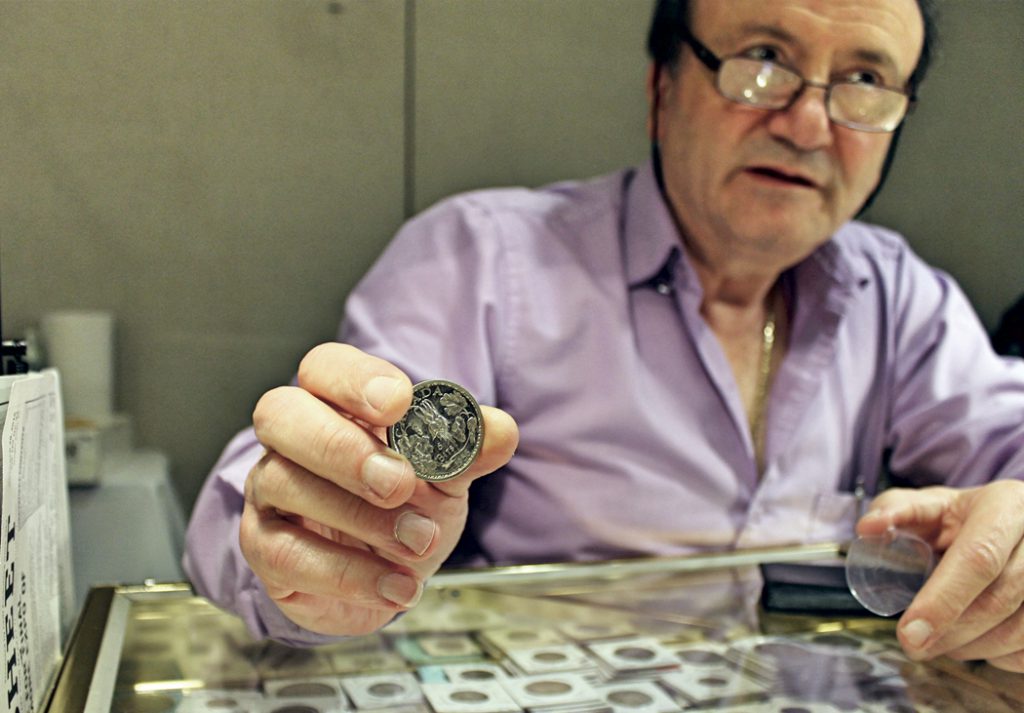By Jesse Robitaille
Fantasies abound at the recent Torex Coin Show, held Nov. 19-20 in downtown Toronto.
One such fantasy was a 1956-dated silver coin with a denomination of six bits (equivalent to 75 cents) and a design featuring plants of the Aquilegia genus. The coin – believed to be created by an engraver at the Royal Canadian Mint – belongs to Joe Iorio, owner of Vancouver’s J&M Coin & Jewellery.
“It’s a unique piece, and it’s something that’s out of the ordinary,” said Iorio, who has nearly 50 years’ experience as a numismatic dealer. “Finding something unique in the numismatic field is quite unusual and something that you cherish.”
The long-time dealer has quite the history with this specific piece.
“I originally bought it in the mid- to late-1970s from a dealer in Ottawa, who informed me that he bought it from a Mint engraver,” said Iorio. “The engraver told the dealer that it was struck at the Mint and that it was his design.”
Despite this, Iorio added he has been unable to verify where, when or how the coin was produced.
“When I originally bought it, the Mint wouldn’t provide or confirm that they made it at the Mint, but I know that it came from the Mint.”
The fantasy coin spent about three decades in Iorio’s collection before being sold to a “major collector” about 10 years ago.
“What happened is I sold it about 10 years ago, and then I bought it back about three years ago,” he added. “I wasn’t really that excited in selling it in the first place, but he insisted on buying it. When he decided to sell his entire collection, he saved that one for me because he knew I was always interested in buying it back.”
And with the coin back in his collection, Iorio said he’s unsure whether he will ever part with it again.
“I haven’t put a price on it or anything,” he said, adding he bought it back from the aforementioned “major collector” about three years ago.
“Right now, I really haven’t made up my mind whether I want to sell it or not.”
SIX BITS
Iorio said the term “bits” dates back to the U.S. colonial period, adding one bit is equivalent to an eighth of a dollar, or 12.5 cents. Keep in mind this was at a time when the most common form of currency being used was the Spanish dollar – known as the piece of eight – which was worth eight Spanish silver reales.
A Canadian silver dollar has a weight of 23.3276 while Iorio’s coin has a weight of 19.4 grams (more than four-fifths the weight of the silver dollar).
“It has a Proof finish, very detailed and high resolution,” said Iorio, who added the coin “should be 80 per cent” silver. “It is very detailed and very attractive with a beaded rim on both sides.”
AQUILEGIA CANADENSIS
Part of the coin’s mystery is in its design, which depicts a left-facing bust on the obverse with the words “THE PRINCESS AQUILEGIA” engraved around the top edge. On the reverse, various Aquilegia plants are shown alongside the word “CANADA” at the top and the denomination “6 BITS” as well as the year-date “1956” at the bottom.
Aquilegia (also known as granny’s bonnet or columbine) is a genus that includes upwards of 70 species of perennial plants. These perennials, which are plants that live for more than two years, are found in meadows, woodlands and at higher altitudes throughout the Northern Hemisphere, including Canada. The plants of the Aquilegia genus are known for the spurred petals of their flowers.
One of the genus’ species is Aquilegia canadensis (also known as Canadian columbine, Eastern red columbine or Wild columbine), which is native to woodland and rocky slopes in eastern North America, including in New Brunswick, Quebec, Manitoba, Ontario and Saskatchewan.
According to the U.S. Department of Agriculture Natural Resources Conservation Service, Aquilegia canadensis was traditionally used as a remedy for ailments such as headache; sore throat; fever; rash caused by poison ivy; stomatitis; and kidney, urinary and heart problems. There have also been ceremonial uses that include perfume and tobacco; however, the plant’s seeds and roots are “highly poisonous” according to the 1997 book, Edible and Medicinal Plants of the West, by Gregory Tilford.
The genus’ species are also known to be among the first wild flowers brought into gardens as cultivated plants.

